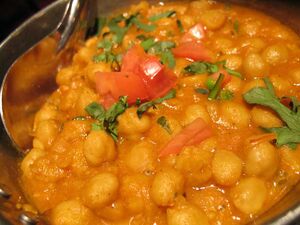


The chickpea (Cicer arietinum) (also garbanzo bean, Indian pea, ceci bean, bengal gram, chana, kadale kaalu, sanaga pappu, shimbra, Kadala) is an edible legume of the family Fabaceae, subfamily Faboideae. Chickpeas are high in protein and one of the earliest cultivated vegetables.
Types
There are two main kinds of chickpea:
- Desi, which has small, darker seeds and a rough coat, cultivated mostly in the Indian subcontinent, Ethiopia, Mexico and Iran.
- Kabuli, which has lighter coloured, larger seeds and a smoother coat, mainly grown in Southern Europe, Northern Africa, Afghanistan and Chile, also introduced during the 18th century to the Indian subcontinent)"
The Desi (meaning country or local in Hindi) is also known as Bengal gram or kala chana. Kabuli (meaning from Kabul in Hindi, since they were thought to have come from Afghanistan when first seen in India) is the kind widely grown throughout the Mediterranean. Desi is likely the earliest form since it closely resembles seeds found both on archaeological sites and the wild plant ancestor of domesticated chickpeas (cicer reticulatum) which only grows in southeast Turkey, where it is believed to have originated. Desi chickpeas have a markedly higher fibre content than Kabulis and hence a very low glycemic index which may make them suitable for people with blood sugar problems. The desi type is used to make Chana Dal, which is a split chickpea with the skin removed.
Cultivation and use
Chickpeas are grown in the Mediterranean, western Asia and the Indian subcontinent. Domestically they can be sprouted within a few days all year round with a sprouter on a windowsill.
Mature chickpeas can be cooked and eaten cold in salads, cooked in stews, ground into a flour called gram flour (also known as besan and used primarily in Indian cuisine), ground and shaped in balls and fried as falafel, fermented to make an alcoholic drink similar to sake, stirred into a batter and baked to make farinata, cooked and ground into a paste called hummus or roasted, spiced and eaten as a snack (such as leblebi). Chick peas and bengal grams are used to make curries and are one of the most popular vegetarian foods in India, Pakistan, Bangladesh and the UK. On the Indian subcontinent chickpeas are called kadale kaalu (Kannada), chana (Hindi and other Indic languages),Chhola (Bengali), konda kadalai or pothu kadalai (Tamil), where they are a major source of protein in a mostly vegetarian culture.
Many popular Indian dishes are made with chickpea flour, such as mirchi bajji and mirapakaya bajji telugu. In India unripe chickpeas are often picked out of the pod and eaten as a raw snack and the leaves are eaten as a green vegetable in salads. Chickpea flour is also used to make "Burmese tofu" which was first known among the Shan people of Burma. The flour is also used as a batter to coat various vegetables and meats before frying, such as with panelle, a chickpea fritter from Sicily. In the Philippines garbanzo beans preserved in syrup are eaten as sweets and in desserts such as halo-halo.
Dried chickpeas versus canned chickpeas
175g of dried chickpeas rehydrates to 400g, the same weight as a tin of chickpeas.
Cooking times
Dried chick peas need a long cooking time (1-2 hours) but will not easily fall apart when cooked longer. If soaked for 12-24 hours before use, cooking time can be considerably shortened to about 30 mins. Don't add any salt during the boiling, it can make them (or any pulses) hard. Add salt after the cooking process.
Portions per person
Allow about 60 g of dried chick peas per person or half a 400g can of cooked chickpeas.
How to cook chickpeas in a pressure cooker
Use this basic guide if you do not have a specific recipe
- Pick through the chickpeas and discard any discoloured peas or loose skins
- Soak in cold water for a minimum of the time shown, soaking overnight is usually the best way to achieve this
- Change soaking water a few times if possible
- Never cook the beans in the water they were soaked in
- Rinse the beans well at the end of the soaking period
- Ensure the pressure cooker is at least a quarter full
- Never fill the pressure cooker more than half full
- Always cover the beans with at least 5 cm (2") water
- Add 2 tablespoons of vegetable oil to the water - this reduces foaming
- Allow the pressure cooker to get to the required pressure and then begin timing
- Use the specified pressure release method - this is the natural method in the case of dried beans or pulses
- A bean is usually perfectly cooked when it can be easily squashed between your forefinger and thumb
- If the beans are not sufficiently cooked, return to pressure, cook for another 3 minutes and allow the pressure to reduce using the natural method.
Re-check that the beans are cooked to your liking.
| BEAN VARIETY | COLD WATER SOAK TIME minimum period |
PRESSURE COOKING TIME | COOKING PRESSURE High = 15 psi Medium = 10 psi Low = 5 psi |
PRESSURE RELEASE METHOD |
| Chickpeas | 8 hours | 25 minutes | High | Natural |
See also
- Instructions and pressure cooking times for more than 20 types of bean
- Detailed index and cooking information for more than 20 bean varieties
- Pressure cooking information and pressure cooking recipes
- Garbanzo de Fuentesaúco
Find recipes that contain 'Chickpeas'
#chickpeas #beans #pressurecooker #pulses #naturalmethod #batter #vegetables #naturalpressurereleasemethod #pressurereleasemethod #vegetableoil #falafel